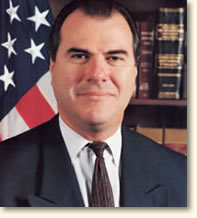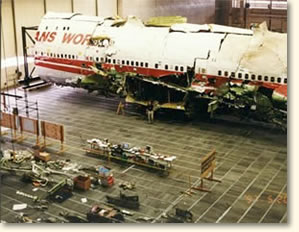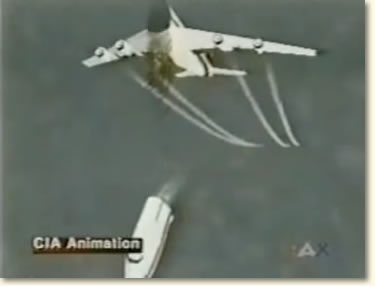
 |
As is often the case in my writing life, outrage, in this case over Wright and his Pulitzer, led to notes/lists (plus macabre doodles) on a scratch pad, which led to research, which led to the desire to publicly castigate the source of my outrage. I would dissect Wright's book and via an essay-exposé ease the molar-grinding tension.
I made a list of FBI agents whose doings bore on matters of Wright's deceptions and started making calls, leaving messages. At first none returned; no surprise there. Then I got lucky. Since 9/11, one of the supporting characters had changed jobs. He was now at Public Affairs of the FBI; his job involves dealing with people like me. The agent's name is Mark Rossini.
At the time of 9/11 Rossini was the FBI representative at the CIA's Alec Station, which had as its de facto mandate the tracking of Osama bin Laden.
But for our purposes here, Mark Rossini is notable in that he was very close to John O'Neill, the “rogue” FBI agent who is said to have been obsessed with Osama bin Laden and the danger of al-Qaeda since the mid-1990s. (Rossini's ignominious termination from the FBI in 2008 is an interesting though probably not germane sidebar.)

According to Wright (and others) O'Neill was pressured to resign from the FBI (possibly for his doggedness and outspokenness in the pursuit of bin Laden), which he did in August of 2001, about three weeks before 9/11. He took the job as head of security for the WTC, and was killed that day. PBS did a documentary on O'Neill, titled The Man Who Knew, meaning 'knew' that a 9/11 kind of attack by Al Qaeda was coming. PBS, like Lawrence Wright before him, unequivocally lionizes O'Neill as all but a super-hero, a martyr felled by the bureaucratic 'failure in imagination' which, according to the official story, led to the success of the attacks.

Indeed, to the 9/11 Truth community itself, John O'Neill was a 'real' anti-terror patriot, driven by the deep state from his post as Guardian of Our Safety and given the job as WTC Security Chief to silence him regarding the dangerous truths he harbored. That, in brief, is the John O'Neill Legend.
When Agent Rossini returned my first phone call, I brought up The Looming Tower, saying I was looking to expand on certain aspects of it. (I held back my real reason for calling him, and my real opinion of the book.) Rossini immediately said, 'The Looming Tower is a great book.' (That an FBI public relations operative would have this opinion of the book is implicit confirmation that it's a crock of shit.)
Rossini was affable (it's after all his job) as we chatted and made tentative plans to meet. Then I brought up John O'Neill, who Wright says was 'idolized' by Rossini; Rossini was one of 'The Son's of John' in the FBI. The two were not only colleagues but buddies.
Here's how it went:
Me: John O'Neill. Whoa. There's an interesting character.
Rossini: Oh yeah, John is a great guy.
The hairs on my neck were on end, my mind racing. I kept silent, replaying in my mind's ear what I had just heard.
No doubt about it: 'John is a great guy.'
Meanwhile, Rossini had lost his cool; he was fast talking me and stuttering a segue-less change of subject.
Rossini's flustered reaction is just as important a factor as the 'is slip': had the 'is' been 'innocent' and reflective of nothing, he would have said something acknowledging it or laughed or even not noticed it. It was 100% clear that he was trying to distract me from it. He was frazzled. FBI agents don't frazzle easily. (If you've ever lost someone close to you, try to picture yourself years later referring to that person in the present tense. Can you do it? I can't.)
I can tell you this: As a nonfiction writer, over the years I've had a few rushes of insight due to an interviewee's blurt, but none to compare with the rush I had on the phone when former counterterrorism FBI agent Mark Rossini used the present tense in describing his friend and mentor and hero John O'Neill, the legend who was supposedly killed on 9/11.
But my rush of insight that John O'Neill survived the events of 9/11 – and that at the very least had foreknowledge of the plot and faked his death that day – is not only based on Rossini's slip of the tongue. In fact, for our purposes here, you can discount it. And indeed, for me the 'is' functions mainly as a denial-buster; a way of seeing reality without the smoke screen of what I want to be true. (I also come back to it when I have irrational pangs of doubt about the inescapability of the conclusions I delineate in this essay.)
At the time of my conversation with Rossini, I had already done a lot of research on a lot of subjects, including the mid-air destruction of TWA Flight 800 off Long Island in 1996. When the 747, bound for Paris and in the final stages of an uneventful climb to cruising altitude, suddenly out of nowhere (at about 13,000 feet) blew itself to smithereens, terrorism was the immediate assumption; the FBI, including anti-terrorism guru John O'Neill, was brought in to investigate.

Freelance journalist Jack Cashill has done an excellent and exhaustive study of the matter, which I highly recommend; for our purposes suffice to sum up the investigation as a cover up only bested in blatant contempt (for both the truth and our collective intelligence) by the 9/11 one.
Proof of this is the 'zoom-climb' animation perpetrated by the CIA, and which was crafted to discredit more than 200 eyewitnesses who saw a missile rise from the water off Long Island and shoot down TWA Flight 800.
Take a look at the 'Zoom-climb ![]() '; it's worth the digression.
'; it's worth the digression.
For me, physics is common sense on steroids. But using either, I can tell you this: blow up the front 30% of an aircraft and the rest of the thing ain't going up, not for several thousand feet, not in the this universe. (
If you prefer to hear this from experts, fine.![]()

The 'zoom-climb' travesty is right up there with the idea that desks and drapes burning brought down Building 7. (Although, as with 9/11, every aspect of the official TWA 800 story is balderdash, I'll add one other thought, and for continuity I'll stick to the 'zoom-climb': A 747, even with the weight of the front of the aircraft removed, does not have sufficient thrust to 'go ballistic' – fly straight up – at all, certainly not for 'several thousand feet.' Impossible by the laws of aerodynamics/physics.)
According to Lawrence Wright, it was John O'Neill who was behind this aspect of the TWA Flight 800 cover up (although, to be sure – surprise! surprise! – Wright has no problem with the 'zoom-climb,' somehow interpreting it as 'good work' on O'Neill's part). Let's quote from the Pulitzer Prize-winning The Looming Tower:
O'Neill proposed that the [impression of a missile attack] could have been caused by the ignition of leaking fuel from the aircraft, and he persuaded the CIA to do a video simulation of this scenario, which proved to be strikingly similar to the witnesses' accounts.
Strikingly similar? Actually, no. In fact, every eyewitness interviewed about the 'zoom-climb' stated emphatically that the animation
bore no resemblance to what they saw![]() .
.
John O'Neill actively participated in the cover up of the truth in a terrorism investigation involving the death of hundreds of Americans.
You look at O'Neill's life, the truth is that he a was profoundly dishonest man. In a rare moment of candor, Wright – whose book all but imparts sainthood upon O'Neill -- describes our man thus: 'He was an adulterer, a philanderer, a liar, an egotist, and a materialist.' (This description is in the context of how O'Neill was now 'reaching for a spiritual handhold.' Indeed!) In my view, you want to know the mettle of a man, examine how he treats those close to him. We do that with O'Neill, 'adulterer' and 'philanderer' and 'liar' ![]() somehow become understatements. 'Sociopath' is the word that comes to mind.
somehow become understatements. 'Sociopath' is the word that comes to mind.
|
Essay by Allan Weisbecker | Visit www.banditobooks.com to learn more © Bandito Books, Ltd. |